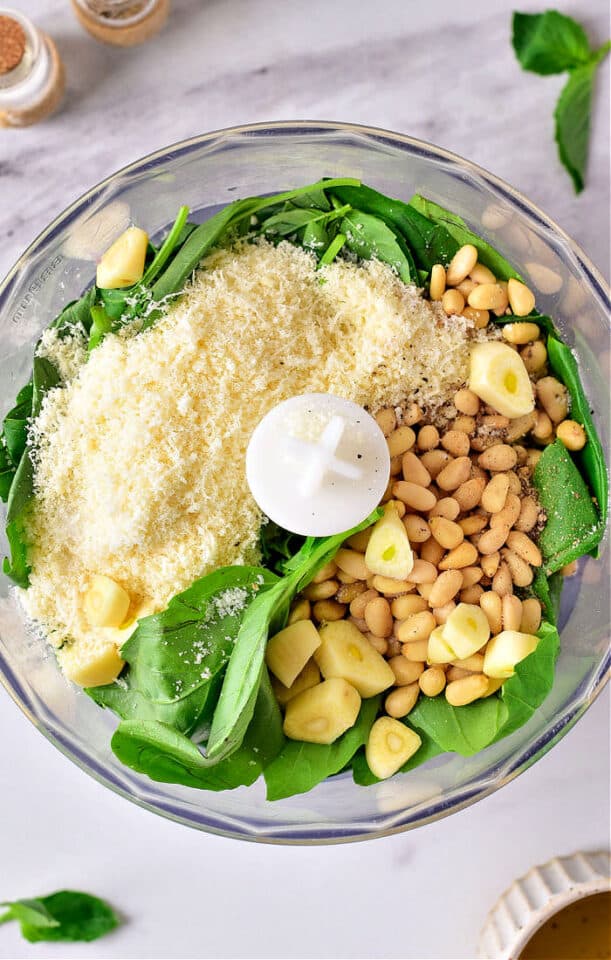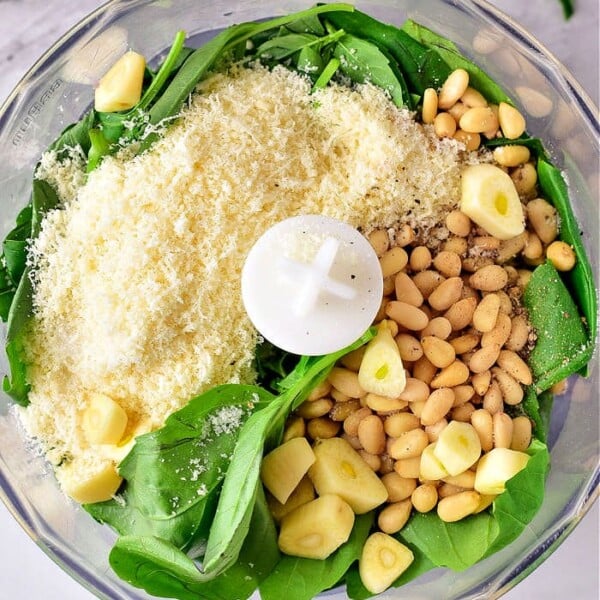
A Taste of the Ancient: Native American Pine Nut Pesto
The whisper of pine needles, the earthy scent of the forest floor, and the subtle, sweet crunch of pine nuts – these are the sensory hallmarks of the American wilderness. For millennia, Indigenous peoples of North America have woven these elements into their diets, not just for sustenance, but as a profound connection to the land. Among their culinary treasures, pine nuts, or piñon nuts as they are often called, hold a special place. And when combined with other foraged ingredients, they form the foundation of a truly remarkable dish: Native American Pine Nut Pesto.
This isn’t your Nonna’s pesto. While the familiar Italian classic relies on basil, Parmesan, and garlic, Native American pine nut pesto draws its vibrant flavors from the bounty of the American landscape. It’s a testament to ingenuity, resourcefulness, and a deep understanding of the natural world. This article will delve into the rich history and cultural significance of pine nuts in Native American cuisine, explore the unique ingredients that define this ancient pesto, and provide a comprehensive recipe so you can recreate this delicious and meaningful dish in your own kitchen.
The Sacred Pine Nut: A Cornerstone of Indigenous Diets

Pine nuts, harvested from the cones of various pine tree species, have been a vital food source for Native American tribes across North America for thousands of years. Their nutritional value is impressive, packed with healthy fats, protein, and essential minerals like magnesium and zinc. More than just calories, however, pine nuts were imbued with cultural and spiritual significance.
The process of harvesting pine nuts was often a communal activity, a ritual that brought families and tribes together. It involved knowledge passed down through generations, understanding the cycles of the trees, the best times to harvest, and the most efficient ways to extract the precious nuts from their woody shells. Tribes like the Pima, Navajo, Paiute, and many others living in the arid Southwest and the mountainous regions of the West, relied heavily on piñon nuts as a staple. They were eaten raw, roasted, ground into flour for breads and cakes, or incorporated into stews and other dishes.
The act of gathering and preparing pine nuts was more than just acquiring food; it was an affirmation of their relationship with the earth. The trees were seen as generous providers, and the harvest was approached with respect and gratitude. This connection to the land is a defining characteristic of Native American culinary traditions, and pine nut pesto beautifully encapsulates this philosophy.
Beyond Basil: The Unique Flavors of Native American Pesto
While the concept of a ground nut-based sauce isn’t exclusive to Italy, the specific ingredients that elevate Native American pine nut pesto are distinctly regional. Instead of basil, which is not native to North America, Indigenous cooks would have utilized a variety of wild greens and herbs available in their environment.
-
Wild Greens: The choice of greens would vary depending on the specific tribe and their geographical location. Possibilities include:

- Wild Spinach (Chenopodium spp.): Also known as lambsquarters, this abundant and nutritious wild green offers a mild, slightly tangy flavor that works wonderfully in pesto.
- Amaranth (Amaranthus spp.): Another ancient grain and leafy green, amaranth provides a slightly earthy and nutty undertone.
- Purslane (Portulaca oleracea): This succulent, slightly lemony green adds a refreshing element.
- Dandelion Greens (Taraxacum officinale): While often considered a weed in modern gardens, dandelion greens offer a pleasant bitterness that can be balanced with other ingredients.
- Wild Mustard Greens (Brassica spp.): For those who enjoy a bit more bite, wild mustard greens can add a peppery kick.
-
Aromatic Elements: Garlic, while now widely cultivated, wasn’t always a staple in pre-Columbian Native American diets in the same way it was in the Mediterranean. Instead, other aromatics would have been used:
- Wild Onions and Leeks (Allium spp.): These wild relatives of cultivated onions and leeks provide a pungent and savory foundation.
- Wild Garlic: Similar to wild onions, offering a milder garlic flavor.
- Juniper Berries (Juniperus spp.): In some regions, the slightly resinous and peppery flavor of juniper berries could have been incorporated, adding a unique aromatic complexity.
-
Acidity and Tang: To balance the richness of the pine nuts and the earthiness of the greens, a source of acidity would have been crucial.
- Wild Berries: Dried or fresh wild berries, such as cranberries or chokecherries (though chokecherries require careful preparation due to tannins), could offer a tart counterpoint.
- Vinegar (if available through trade or later cultivation): In later periods, vinegar would have been introduced and utilized.
-
Fat and Binding Agent: While olive oil is the modern pesto staple, Native Americans would have used rendered animal fats or other available oils.
- Rendered Animal Fats: Bear fat, deer fat, or other animal fats were common sources of richness.
- Nut Oils: Oils pressed from other native nuts could also have been used.
The Art of Making Native American Pine Nut Pesto: A Step-by-Step Guide
Creating this pesto is a journey back in time, a chance to connect with ancient culinary practices. The process is relatively straightforward, but the resulting flavor is anything but simple.
Yields: Approximately 1.5 cups
Prep time: 15 minutes
Ingredients:
- 1 cup toasted Native American pine nuts (piñon nuts): Toasting brings out their sweetness and aroma. You can do this gently in a dry skillet over medium-low heat until fragrant, or in a single layer on a baking sheet in a 300°F (150°C) oven for 5-8 minutes. Be careful not to burn them.
- 2 cups packed fresh wild greens: A mix is best! Consider lambsquarters, amaranth, purslane, or young dandelion greens. Wash them thoroughly. If using tougher greens, a quick blanch in boiling water for 30 seconds followed by an ice bath can tenderize them.
- 1-2 cloves wild garlic or 1 small wild onion, roughly chopped: Adjust to your preference for pungency.
- 1/4 cup rendered animal fat (such as lard or duck fat) OR 1/4 cup mild olive oil: For a more traditional approach, use rendered animal fat. Olive oil is a modern, accessible substitute.
- 1-2 tablespoons dried wild berries (optional, for tartness): Cranberries or dried sour cherries work well. Rehydrate them in warm water for 10 minutes before using if very dry.
- 1/2 teaspoon sea salt or to taste:
- Pinch of freshly ground black pepper (optional, if available):
- Optional additions:
- 1/4 teaspoon crushed juniper berries (for a resinous, peppery note): Use sparingly.
- Juice of 1/4 lemon or lime (for brightness, if not using berries for acidity):
Equipment:
- Mortar and pestle (for the most traditional experience) OR a food processor.
- Skillet or baking sheet for toasting nuts.
- Measuring cups and spoons.
Instructions:
- Toast the Pine Nuts: If you haven’t already, toast your pine nuts as described in the ingredients section. Allow them to cool slightly.
- Prepare the Greens: Wash your chosen wild greens thoroughly. If using any tougher varieties, you can briefly blanch them in boiling water and then shock them in ice water to preserve their color and tenderize them. Drain them very well.
- Combine Ingredients:
- Using a Mortar and Pestle (Traditional Method):
- Add the toasted pine nuts and a pinch of salt to the mortar. Grind them into a coarse paste.
- Add the chopped wild garlic or onion and continue to grind until well incorporated.
- Gradually add the wild greens, a handful at a time, and pound and grind until a thick paste forms.
- Stir in the rendered fat or olive oil, a little at a time, until the pesto reaches your desired consistency.
- If using dried berries or juniper berries, grind them in separately before adding them to the main mixture or stir them in at the end.
- Season with salt to taste.
- Using a Food Processor (Modern Method):
- Add the toasted pine nuts, wild garlic or onion, and salt to the bowl of your food processor. Pulse until coarsely chopped.
- Add the well-drained wild greens. Process until the mixture is finely chopped, scraping down the sides of the bowl as needed.
- With the processor running, slowly drizzle in the rendered fat or olive oil until the pesto is smooth or to your desired consistency.
- If using dried berries or juniper berries, you can add them at this stage and pulse to combine.
- Taste and adjust seasoning with salt. If you are not using berries for acidity, you can add a squeeze of lemon or lime juice for brightness.
- Using a Mortar and Pestle (Traditional Method):
Serving Suggestions: Honoring the Legacy
Native American pine nut pesto is incredibly versatile. It can be served in a multitude of ways, each honoring the spirit of its origins.
- With Game Meats: This pesto is a natural pairing for roasted or grilled game meats like venison, rabbit, or fowl. The rich, savory notes of the meat are beautifully complemented by the nutty, herbaceous pesto.
- As a Dip or Spread: Serve it with freshly baked cornbread, bannock, or other traditional Indigenous breads. It also makes a delightful dip for roasted root vegetables like squash, sweet potatoes, or parsnips.
- Tossed with Grains: Imagine a hearty bowl of quinoa, amaranth, or wild rice tossed with this flavorful pesto. It transforms simple grains into a satisfying and delicious meal.
- Dolloped on Roasted Vegetables: A spoonful of this pesto adds an instant burst of flavor to any roasted vegetable medley.
- As a Flavor Enhancer for Stews: Stir a dollop into a simmering stew to add depth and complexity.
A Culinary Connection to the Past
Making and enjoying Native American pine nut pesto is more than just a culinary experience; it’s an act of cultural preservation and appreciation. It allows us to connect with the ingenuity and wisdom of the Indigenous peoples who have lived in harmony with this land for generations. By understanding the ingredients, the preparation methods, and the cultural significance, we can truly savor the taste of the ancient.
In a world that often rushes forward, taking the time to prepare a dish like this offers a moment of reflection. It reminds us of the importance of foraging, of respecting the earth’s bounty, and of the profound connection between food, culture, and heritage. So, the next time you find yourself with a handful of pine nuts and a desire for something truly unique, consider making this ancient pesto. It’s a taste of history, a whisper of the wild, and a delicious testament to the enduring legacy of Native American cuisine.


